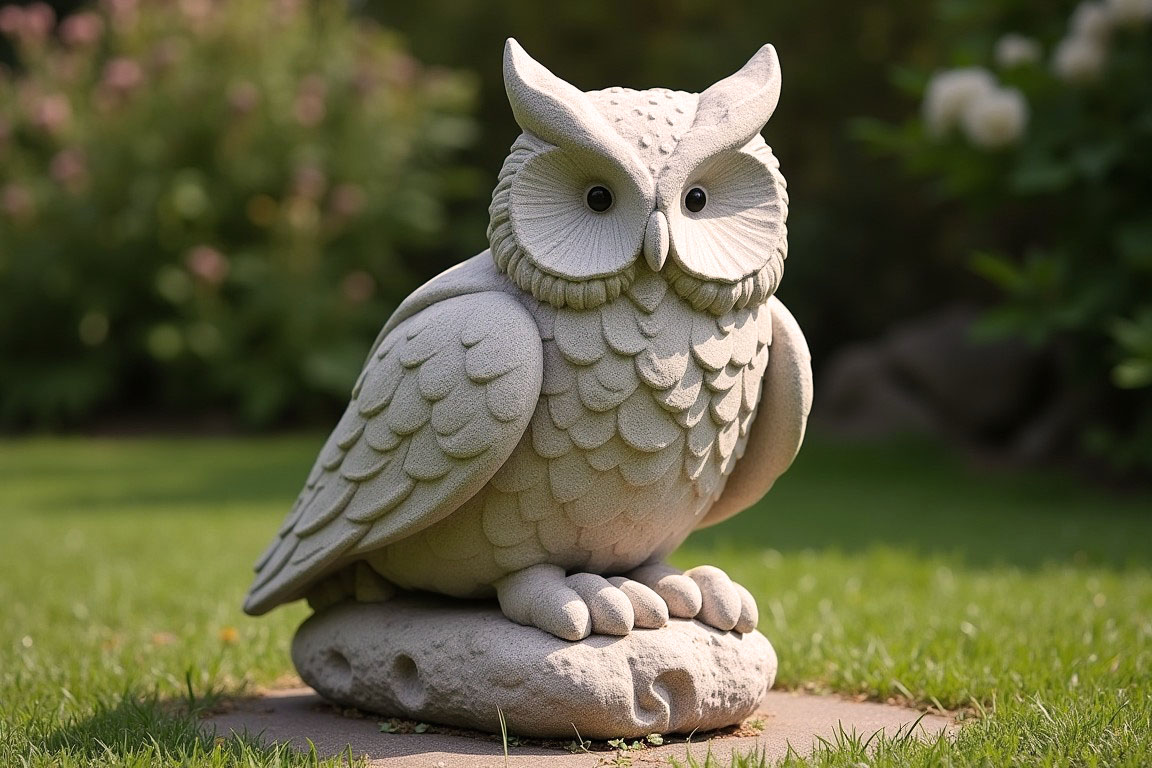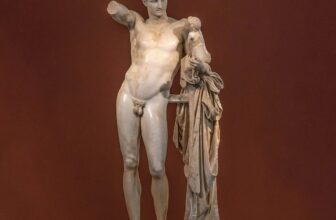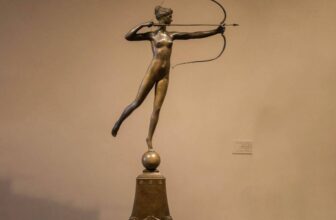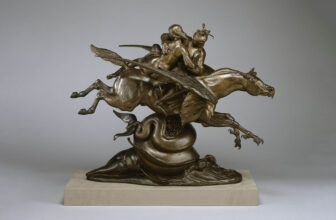
What Does the “Owl on a Branch” Sculpture Represent
In the heart of an ancient woodland garden, where the wind whispers through gnarled trees and the moonlight paints silver shadows across stone and earth, there stands a sculpture: an owl perched quietly on a branch. Silent, watchful, unmoving, yet full of unspoken power.
This “Owl on a Branch” sculpture is no ordinary ornament. To the casual eye, it might appear to be a simple decorative object, a garden piece, a charming addition to a rustic corner, or an elegant figure on a mantelpiece. But for those who take a moment to stop and observe, the sculpture offers something more: a presence. A story. A deep, enduring symbol woven into the spiritual and cultural fabric of civilizations across time.
This is not just art; it is archetype, memory, and meaning, cast in stone, bronze, wood, or ceramic.
The image of an owl on a branch is more than aesthetic, it’s symbolic. The sculpture speaks to themes of:
Wisdom
Mystery
Transition
Protection
Observation
Across cultures, the owl has been revered, and sometimes feared, as a creature of significance. When an artist chooses to immortalize an owl sitting on a branch, they’re capturing a moment of alert quiet, as if the bird is pausing to study the world, ready to act but choosing stillness.
The branch, meanwhile, serves not only as a perch but as a bridge between the earth and sky, symbolizing balance and connection between the seen and unseen worlds.
Together, the owl and branch form a deeply layered image. It’s as though the owl sits at a liminal point, watching both the world of the living and the world of spirit, perched between knowledge and intuition, between light and shadow.
Is an Owl Sculpture Lucky or Unlucky?
Like many powerful symbols, the owl’s meaning varies across cultures. Some see it as a sign of good fortune, while others associate it with omens or even death. The answer depends on context, belief system, and placement.
Lucky Interpretations:
In Greek mythology, the owl is sacred to Athena, the goddess of wisdom and war. Her owl is often shown sitting on a branch, eyes wide open, guarding secrets of the universe. To the Greeks, the owl was a symbol of protection and insight, and even appeared on coins as a sign of prosperity.
In Feng Shui, owl figurines are used to attract positive energy, clarity of thought, and protective chi. Placing an owl sculpture in the home or garden is believed to guard against negative forces and increase the flow of helpful, guiding energy.
In Native American traditions, some tribes regard the owl as a wise guardian, particularly one that watches over the night. It brings messages, warnings, and insight to those who know how to listen.
Unlucky Interpretations:
In some African and Middle Eastern cultures, the owl has been viewed as a harbinger of death or misfortune. Its nocturnal habits and eerie calls made people associate it with mystery, secrecy, and the unseen, qualities that can be misinterpreted as ominous.
Certain European superstitions hold that owls are witches in disguise or creatures that announce impending doom. These views are more folklore than grounded belief today, but they influence the perception in some regions.
So, is an owl sculpture lucky or unlucky? It depends on what you believe. But in modern spiritual and artistic communities, the owl is largely viewed as a symbol of protection, wisdom, and higher vision. Its stillness, its gaze, its solitude, all are qualities many seek to cultivate.
Symbolism of the “Owl on a Branch” Sculpture
Symbolism gives meaning to matter. In the case of the “Owl on a Branch,” each element is a metaphor.
1. The Owl: Wisdom, Insight, and Intuition
Owls are birds of prey, but unlike falcons or eagles, they strike from the dark. They rely not on brute strength but on stealth, silence, and surgical precision. This gives them an air of mysticism and intelligence.
An owl represents:
Wisdom – The kind that comes from observation, not books.
Intuition – Knowing what lies beyond what is visible.
Awareness – Eyes wide open, ever vigilant.
Adaptability – Ability to see in darkness and hear whispers.
In sculpture, these qualities are preserved. The artist captures the owl’s poise, the slight forward tilt of the head, the alert stance of talons gripping the branch, and the intensity of those fixed, forward-facing eyes.
2. The Branch: Stability and Perspective
A branch is more than a seat, it’s symbolic of:
Balance – Suspended between earth and sky.
Elevation – A higher vantage point, rising above the noise.
Pause – The calm moment before action.
Connection to Nature – A reminder that we all perch somewhere in life’s tree, momentarily.
By placing the owl on a branch, the sculpture emphasizes the theme of observation before movement. It’s the quiet moment of preparation before diving into the unknown.
3. Combined Symbolism: The Philosopher in the Forest
When united in sculpture, the owl on the branch is a portrait of mindfulness. It invites viewers to step out of their fast-paced lives and observe, observe their surroundings, thoughts, feelings, and inner truths.
Meaning of the Owl on a Branch Sculpture
Spirituality isn’t about dogma; it’s about presence. The “Owl on a Branch” sculpture, whether in a home, temple, garden, or sacred space, speaks deeply to the soul’s longing for truth and clarity.
Here’s what it might mean to the spiritual seeker:
1. A Guardian of Inner Truth
The owl doesn’t speak. It watches. In spiritual terms, this translates to introspection. The sculpture can remind us to quiet the mind, listen deeply, and trust the wisdom that arises from stillness.
2. A Symbol of Transformation
Owls are nocturnal, navigating the unseen. They are natural guides through darkness. Spiritually, they represent the Dark Night of the Soul, the challenging periods we must endure to emerge wiser, more authentic, more connected.
3. A Connection to the Spirit World
In many shamanic and indigenous traditions, owls are messengers between worlds. They bring knowledge from the spirit realm into this one. Having a sculpture of an owl on a branch is like inviting that channel into your space, a silent intermediary for divine wisdom.
Is “Owl on a Branch” Good for Garden Sculpture?
Absolutely, and here’s why:
1. Harmony with Nature
The sculpture blends seamlessly into natural surroundings. An owl on a branch doesn’t clash with flowers, trees, or stone paths, it complements them. It echoes the stillness of the forest, the rhythm of wind and leaf.
2. Protection and Presence
Many gardeners place owl sculptures not only for beauty but to ward off pests. While some use plastic owls to deter rodents or birds, a well-crafted sculpture can also serve as a symbolic protector of the garden, watching over it like a silent sentinel.
3. Aesthetic and Meditative Appeal
Placed near a water feature, under a tree, or beside a garden bench, the “Owl on a Branch” invites reflection. It creates a sense of calm and mindfulness, turning a simple garden into a sanctuary.
4. Weather-Resistant Beauty
Stone, bronze, and resin versions of the sculpture are durable and age beautifully. The patina that forms over time enhances the sculpture’s mysterious charm, making it seem even more timeless, like it has always been there, waiting.
A Story Within the Sculpture
Imagine this scene:
In a quiet garden in the early hours before dawn, a woman sits on a bench wrapped in a wool shawl, sipping tea. She’s gone through a hard year, loss, change, uncertainty. She looks up and sees the silhouette of her garden owl sculpture outlined by moonlight.
She’s seen it a hundred times before, but this morning, something feels different.
The owl doesn’t move, doesn’t speak. But in its carved, patient silence, she hears something: “Wait. Watch. Trust.”
It’s as though the sculpture, grounded and eternal, is reminding her that she too can survive the dark, find her wisdom, and emerge on the other side changed, but whole.
In that moment, the owl isn’t just decoration, it’s guide, mirror, and companion.
More Than Stone and Wood
The “Owl on a Branch” sculpture is a testament to the power of symbolism, the richness of nature, and the depth of stillness. Whether placed in a garden, a study, a meditation room, or by a windowsill, it speaks softly but clearly:
Know yourself.
Embrace quiet wisdom.
See what others overlook.
Be still, but alert.
Trust the dark, it too has its lessons.
It may be carved, cast, or molded, but the energy it carries is alive.
So, is the owl sculpture lucky or unlucky? To those who believe in growth, awareness, and quiet power, it is one of the luckiest symbols you can invite into your life.
Let it perch in your space, not just as an ornament, but as an ally in your journey toward understanding.




